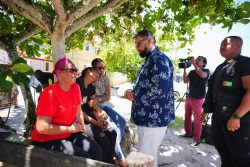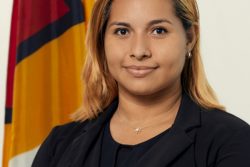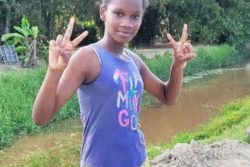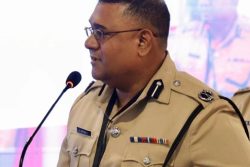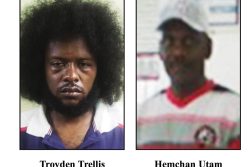 Art neither exists in a vacuum nor does it emerge from one. I know the idea of the artist as a lone and individual character, stoically observing the world, and passionately critiquing it is one that has stuck. On the other hand, so has the idea of the artist as a somewhat odd character, marching to the beat of his or her own drum, creating statements that are years ahead of his or her own time or from an entirely different reality. In this latter construction, somehow, the artist is a kind of seer. Yet, despite the tremendous power imbued to them, they seem to be the most irrelevant of beings in Guyana. Not that I think they are. Absolutely not. But they are treated as such.
Art neither exists in a vacuum nor does it emerge from one. I know the idea of the artist as a lone and individual character, stoically observing the world, and passionately critiquing it is one that has stuck. On the other hand, so has the idea of the artist as a somewhat odd character, marching to the beat of his or her own drum, creating statements that are years ahead of his or her own time or from an entirely different reality. In this latter construction, somehow, the artist is a kind of seer. Yet, despite the tremendous power imbued to them, they seem to be the most irrelevant of beings in Guyana. Not that I think they are. Absolutely not. But they are treated as such.
As a practising artist in Guyana, my journey has not been easy. While I see what I, we, bring to the world as relevant, in Guyana it is not seen that way. Someone near and dear to me is fond of saying, “if it can’t be measured, weighed, or quantified in units such a yard, pound, etc. it will never be given value in this country.” That seems to be the case. So, while I write this article in Budget season (to be read in March), I am not looking at what will be spent on art and the arts because I am sceptical about how much and more importantly, how it will be spent. I want to see legacies of expenditure. I don’t care who is doing the spending. I care more about equity and the afterlife of money spent.
Seems these days in Guyana, the hot topic for justifying art is aligning visual art with therapy. I read here and there about Guyanese artists who laud the benefits of art in their healing journeys and processes. And I am excited by this, but I am also concerned because art therapy is a profession for which people are trained and no one is trained (or am I mistaken?) as an art therapist here. Years ago, I recall a senior official querying whether a certain tertiary institution had the capacity to train art therapists. The aim was for there to be art therapists in Guyana. Lovely! But alas, the training was not possible then, and years later it is not.
I read here and there about the high rate of suicide in Guyana. I also read here and there about art’s therapeutic power. And I think this is all wonderful! Not the high rate of suicide! No! Of course, not! I think it is wonderful that the discussion on how to stymie these occurrences include discussions on the therapeutic power of art.
The violence of our existence is so commonplace that it is normal. I think of the plantation. I live on a former plantation, as do many Guyanese. I didn’t always. I lived most of my life in Georgetown. But then again, as a child I heard stories of the Dutch burning plantations with the enslaved in them and that South Ruimveldt Gardens – one of the places where I grew up – is a former plantation. My imagination was a bit too active so you can imagine what happened to me. But I never said anything to anyone. This is my first confession. Now I live on a former plantation. Still rural despite the loss of trees to grand edifices of concrete. After four years of living on ancestral land, I ran away from it. But running didn’t help. I ran away, quite honestly, because I couldn’t bear the screams of children being punished off in the distance. I kept hearing mothers saying, “I gun do it, so Massa won’t.” History’s truths were haunting me. Last year, a mother let loose on her child in front of my yard. I use the colloquial “let loose” to avoid stronger language. I went out and stopped her. He ran up the road crying and holding his bottom. I think of the brutality learned and perpetrated, passed down generationally.
I admit I don’t know much about the experiences of the indentured. Not to say, I don’t know anything. But theirs too was a miserable experience. Opium. Rum. A lot of bad happenings there. British manipulation of two exploited people whose descendants must share this strip of reclaimed coastal land. These people need healing. The rum shop and concerts with triple X-rated lyrics are not healing. So yes, we all need therapy, perhaps even some art therapy.
We live daily with the by-products of British colonial manipulation. It remains intact here in much the same way as the wealth amassed from Demerara sugar made the UK what it is today. I need healing from this. We need healing from this! I need my paints and my brushes but I am ill-equipped to guide the work I must do to heal myself of all this. I need someone to properly guide me so I don’t do harm to myself.
All this is foremost in my mind because I saw on the back of a minibus today the words, “Beat and teach”. I know there is a dancehall song with those words but since I do not listen to the recent stuff I found myself asking, what did the artiste say about this? Was he in favour or against? And as I write, I think of a certain song that demanded back doors be kicked in if the front door was not opened by the owner of the ‘domicile’. In a sense, our bodies are our homes. We need healing. I could do with an art therapist; I think we all can. “Guyana not easy,” they say. But while they may be speaking of the economics of living here, I ache because of its history.
There should be investment in training art therapists and then provisioning them with adequate spaces and materials to do their job on behalf of all of us who recognise we need healing and know that getting a permanent or remittance to spend will not solve our problems.
Akima McPherson is a multimedia artist, art historian, and educator

